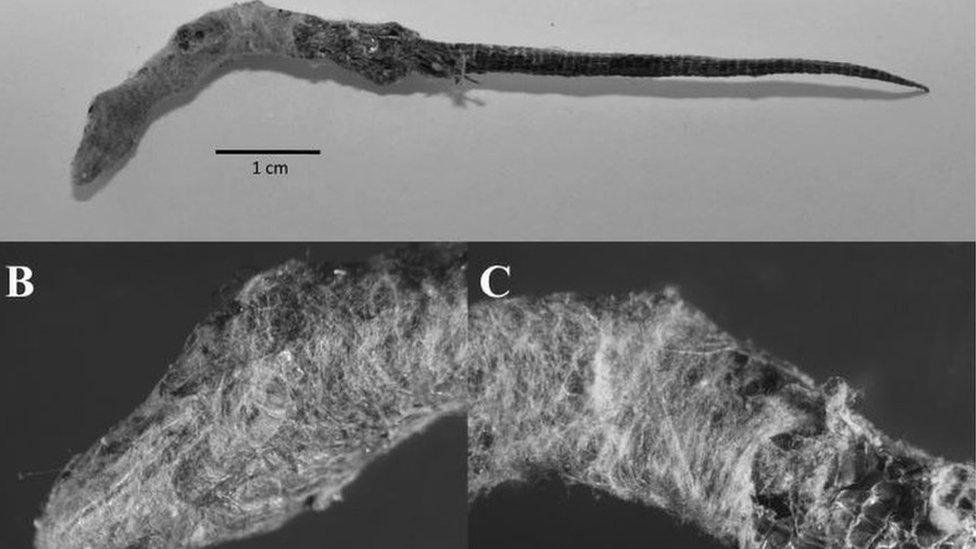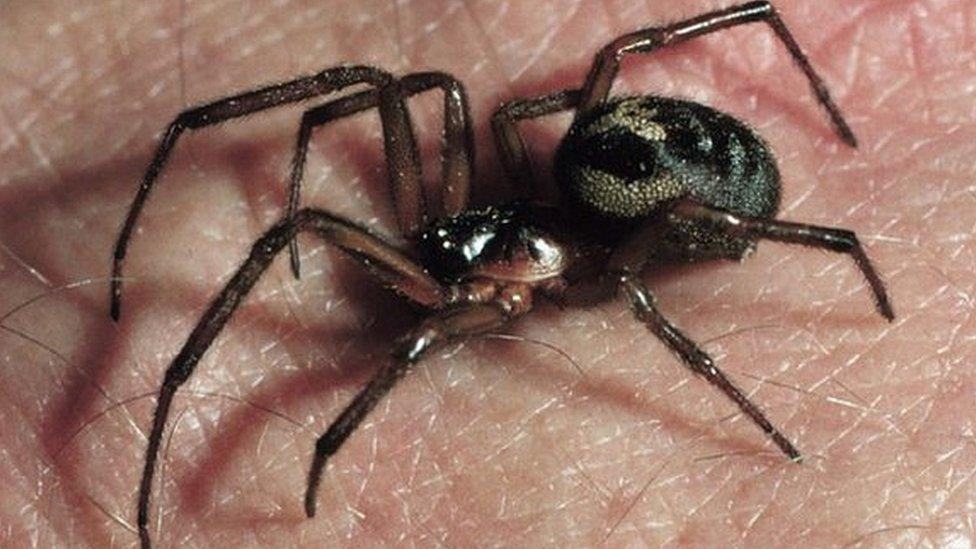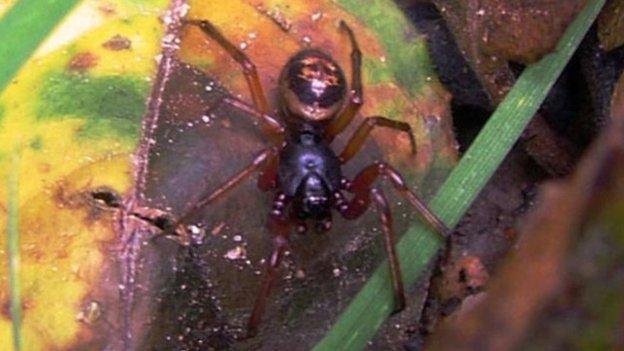False widow spider 'devours' native lizard
- Published
False widow spiders first arrived on the island of Ireland in the 1980s
For the first time a false widow spider has been recorded feeding on Ireland's only native lizard.
The zootoca vivipara, or common lizard, is a protected species in both the Republic of Ireland and Northern Ireland.
A member of the public discovered the spider alongside the small, dead lizard in her garden in County Dublin.
It was was half covered in the false widow's silk, and the spider was seemingly feeding on it.
Michel Dugon, a zoologist at the Ryan Institute at NUI Galway, said the lizard was "completely mummified".
"What we found is that the lizard was completely wrapped in the way a spider would wrap its prey.

The young native lizard was half wrapped in the false widow's silk
"The lizard measured 8.5cm and weighed 0.4 grams. There was nothing left in it except the skin and the bones. The spider just fed on the flesh."
"This spider was feeding at the neck of the lizard. Spiders bite their prey around the neck for the venom to reach the central nervous system.
Gruesome process
"What a spider does is external digestion, it is quite gruesome but very interesting.
"A spider first injects venom with its fangs, then uses the fangs to make a puncture in the skin of the prey and then discharge the content of its stomach into the prey and once all the organs are turned into a kind of broth, she will suck that back up.
"This is how you end up with a completely mummified lizard."

The biggest challenge faced by the zootoca vivipara, or common lizard, is habitat destruction
The venomous false widow spider arrived on the island of Ireland 20 years ago and went largely unnoticed, Mr Dugon said.
Although the unusual event took place in May 2017, researchers from the Ryan Institute at NUI Galway and the Herpetological Society of Ireland have just published their report into it., external
Lizards normally eat spiders, so to find a spider eating a lizard is unusual in itself.
"It is the first time we recorded a bug feeding on a vertebrate in on the island of Ireland," Mr Dugon explained.
He said it also shows the unintended consequence of an alien species successfully overcoming a native lizard.
"It's an excellent example of how an invasive species can go under the radar for 20 years, and when we start it notice it, it is probably too late".


False widow facts:
•False widow spiders arrived in south-west England in the 1870s
•It is Britain's most venomous spider, although there are no reported deaths from its bite in the UK
•The spider has distinctive cream markings on its bulbous body and is brown with reddish-orangey legs
•It eats insects, invertebrates and even other spiders
•It prefers warm, dark places
•The UK has about 650 species of spider and of these only about a dozen are capable of biting humans
Source: Natural History Museum

'Not as deadly as a bee'
The Herpetological Society of Ireland said it wants people to contact it if they come across lizard carcasses.
Co-author of the report, Rob Gandola, said the presence of a false widow isn't the biggest challenge to Irish lizards.
"Rapid urbanisation, houses being built in previously rural areas pose the biggest threat to the survival of the common lizard".
We also shouldn't worry too much about false widow spiders as, Mr Dugon explained, though a bite can be uncomfortable, it is not fatal.
"If you get bit by a false widow you could experience a range of symptoms ranging from swelling, inflammation of the blood vessels, feeling nauseous, all in all it's not fun and as far as we know it's not fatal.
"Every year in the UK approximately five-to-seven people die from bee stings, however most people don't see bees as being deadly creatures.
"Overall a bee is far more deadly than a false widow," he added.
- Published22 February 2012
- Published5 July 2017

- Published23 October 2013
